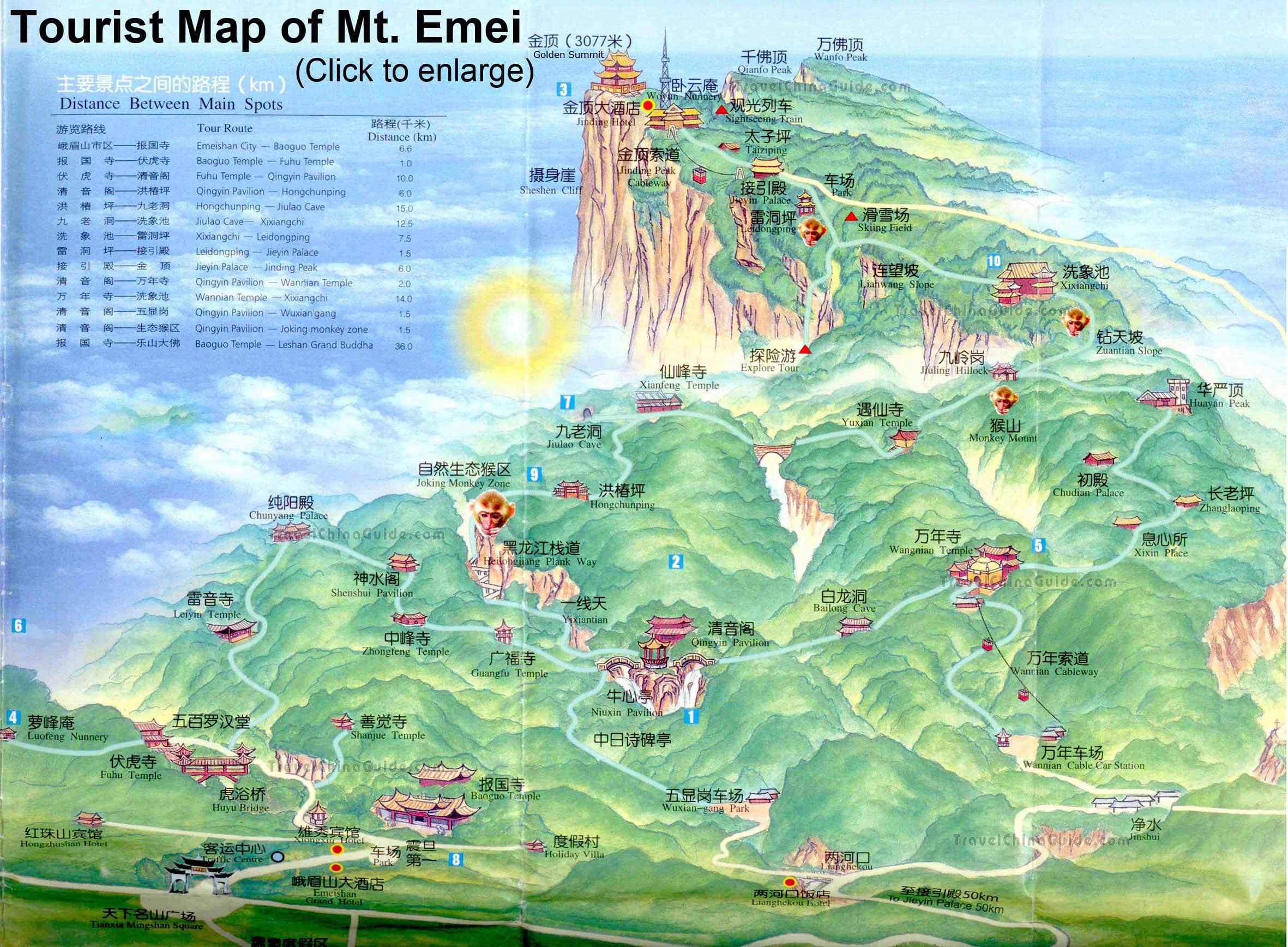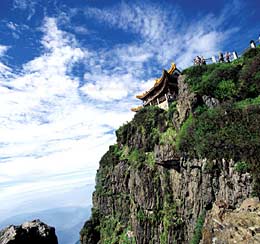Mount Emei
Summit of Emei Shan
Emei Shan (Chinese峨嵋山/峨眉山, Pinyin Emei Shan, W.-G. O -mei Shan, towering eyebrows (眉! ) Mountain ') is one of the four sacred Buddhist mountains in China. With a height of 3099 meters, it extends from the basin of Sichuan Province. The name Eyebrow Mountain comes According to a theory of the elongated shape of the ridge. He was recorded together with the nearby Leshan in the list of UNESCO World Heritage in 1996. The temple on Emei Shan (峨眉山 古 建筑 群, Emei Shan gǔ jiànzhùqún ) are on the list of monuments of the People's Republic of China.
Attractions
The legend of the Buddhist mountain states that the Bodhisattva Samantabhadra (普贤, Pǔxián; joint Japanese) flew on his white three-headed elephant on the mountain. Therefore, the mountain is seen as his whereabouts, or at least associated with it. In Wannian - Sì ( the 10,000 -year mark), the oldest existing temple of the mountain, reconstructed in the 9th century, a 8.5 meter high statue of the Bodhisattva is on his elephant, also from the 9-10. Century. It supposed to bring luck to caress the edges of the elephant.
Of the over one hundred temples of the mountain, a large part of the Cultural Revolution fell victim. About two dozen temples have since become active again, most reconstructed after the Cultural Revolution stamp them are, however, not in good condition, while a few obtained their ancient splendor continues to unfold. Some earn with the rental of rooms to tourists and pilgrims extra income. The Jīndǐng - Sì (Gold Peak Temple ) on the traditionally held for the peak summit height of 3077 meters, is fully reconstructed, demanded entrance and looks more touristy than religious.
Baoguo Sì ( Baoguo Temple )
Since the 6th century, the mountain is said to have been the goal of Buddhist pilgrims. After the Cultural Revolution, and with the rapid increase in domestic tourism in recent years, the number of visitors has increased dramatically again. The ascent on foot, via two different routes ( has traditionally been one for the up and used for the descent ), takes between two and three days. The routes consist almost entirely of stairs. They are less crowded than you might expect, since a new road under construction also allows the road almost to the summit, where you thus suddenly encounters huge crowds, shops and parking. The visit of the mountain is chargeable.
It is famous for its mountain views and the sight of the sunrise, but mostly obscured by fog and clouds. From the top you can sometimes see rainbow-like reflections on the clouds below under lower clouds. This phenomenon was some Buddhists as Pure Land, in the partially so many people tried to jump down that even at the time of the Ming Dynasty as a countermeasure barriers were erected.
Samantabhadra statue on the Gold Summit
At the summit gold a 48 -meter-high statue was erected, representing the Samantabhadra. It consists of copper, coated with gold and is the largest golden Buddha statue in the world. The figure measures 42 meters, comes to an approximately 6 meters higher pedestal. The total height of 48 meters represents the 48 vows of Amitābha. Inside the statue there is a temple.
Input of the statue
Sideview
Flora and Fauna
Spread on the mountain are Tibetmakaken. These monkeys especially at the top so the food donations of visitors ( which also act as Buddhist merit acquisition ) used to partly very aggressive demand their rights. At the summit, special guards are therefore employed, which should restrain the monkeys something.
The area around the Emei Shan is also botanically remarkable because here occurs a number of Lokalendemiten.









